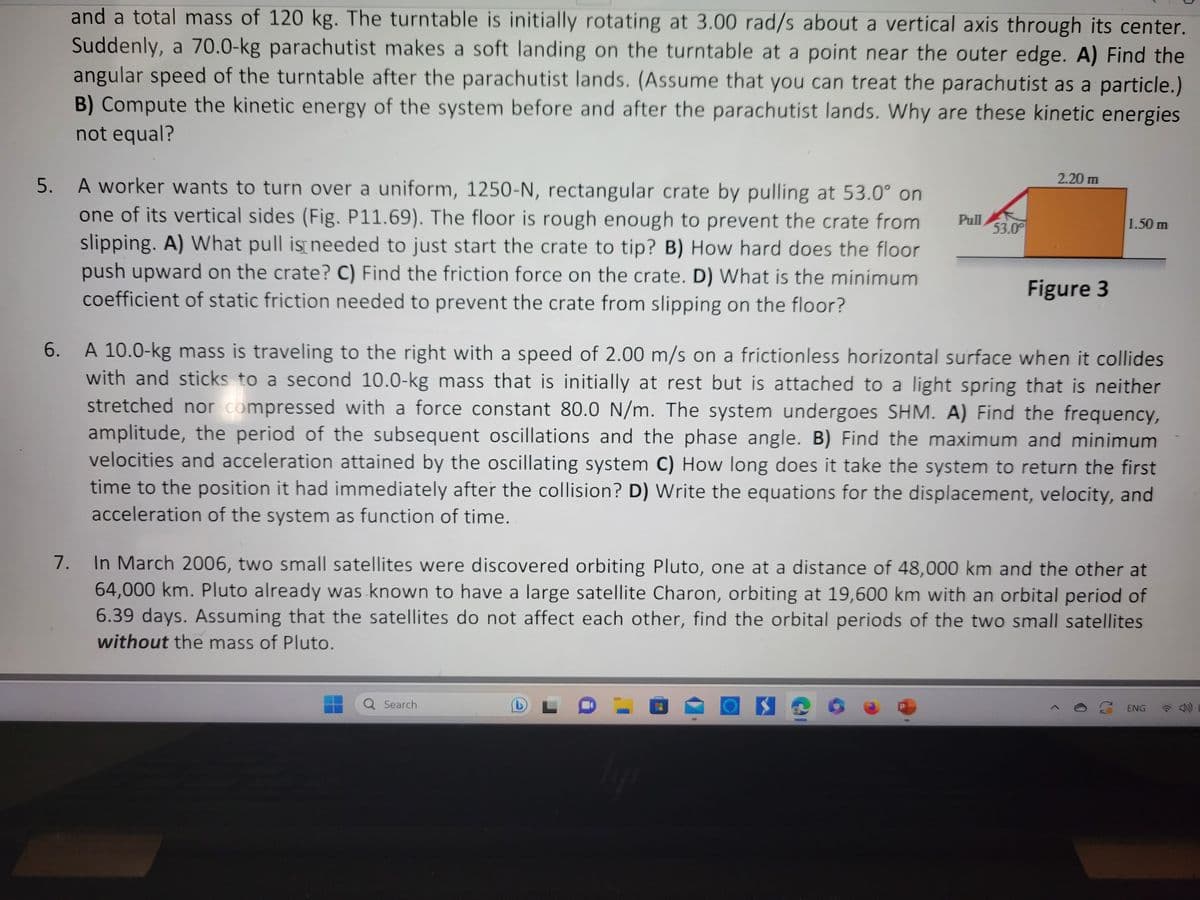A worker wants to turn over a uniform, 1250-N, rectangular crate by pulling at 53.0° on one of its vertical sides (Fig. P11.69). The floor is rough enough to prevent the crate from slipping. A) What pull is needed to just start the crate to tip? B) How hard does the floor push upward on the crate? C) Find the friction force on the crate. D) What is the minimum coefficient of static friction needed to prevent the crate from slipping on the floor? Pul
A worker wants to turn over a uniform, 1250-N, rectangular crate by pulling at 53.0° on one of its vertical sides (Fig. P11.69). The floor is rough enough to prevent the crate from slipping. A) What pull is needed to just start the crate to tip? B) How hard does the floor push upward on the crate? C) Find the friction force on the crate. D) What is the minimum coefficient of static friction needed to prevent the crate from slipping on the floor? Pul
Principles of Physics: A Calculus-Based Text
5th Edition
ISBN:9781133104261
Author:Raymond A. Serway, John W. Jewett
Publisher:Raymond A. Serway, John W. Jewett
Chapter10: Rotational Motion
Section: Chapter Questions
Problem 50P: A disk with moment of inertia I1 rotates about a frictionless, vertical axle with angular speed i. A...
Related questions
Concept explainers
Rotational Equilibrium And Rotational Dynamics
In physics, the state of balance between the forces and the dynamics of motion is called the equilibrium state. The balance between various forces acting on a system in a rotational motion is called rotational equilibrium or rotational dynamics.
Equilibrium of Forces
The tension created on one body during push or pull is known as force.
Question
hellonplease only number 5

Transcribed Image Text:and a total mass of 120 kg. The turntable is initially rotating at 3.00 rad/s about a vertical axis through its center.
Suddenly, a 70.0-kg parachutist makes a soft landing on the turntable at a point near the outer edge. A) Find the
angular speed of the turntable after the parachutist lands. (Assume that you can treat the parachutist as a particle.)
B) Compute the kinetic energy of the system before and after the parachutist lands. Why are these kinetic energies
not equal?
5.
A worker wants to turn over a uniform, 1250-N, rectangular crate by pulling at 53.0° on
one of its vertical sides (Fig. P11.69). The floor is rough enough to prevent the crate from
slipping. A) What pull is needed to just start the crate to tip? B) How hard does the floor
push upward on the crate? C) Find the friction force on the crate. D) What is the minimum
coefficient of static friction needed to prevent the crate from slipping on the floor?
Pull
Q Search
53.0⁰
30
2.20 m
Figure 3
6.
A 10.0-kg mass is traveling to the right with a speed of 2.00 m/s on a frictionless horizontal surface when it collides
with and sticks to a second 10.0-kg mass that is initially at rest but is attached to a light spring that is neither
stretched nor compressed with a force constant 80.0 N/m. The system undergoes SHM. A) Find the frequency,
amplitude, the period of the subsequent oscillations and the phase angle. B) Find the maximum and minimum
velocities and acceleration attained by the oscillating system C) How long does it take the system to return the first
time to the position it had immediately after the collision? D) Write the equations for the displacement, velocity, and
acceleration of the system as function of time.
1.50 m
7.
In March 2006, two small satellites were discovered orbiting Pluto, one at a distance of 48,000 km and the other at
64,000 km. Pluto already was known to have a large satellite Charon, orbiting at 19,600 km with an orbital period of
6.39 days. Assuming that the satellites do not affect each other, find the orbital periods of the two small satellites
without the mass of Pluto.
ENG
Expert Solution
This question has been solved!
Explore an expertly crafted, step-by-step solution for a thorough understanding of key concepts.
This is a popular solution!
Trending now
This is a popular solution!
Step by step
Solved in 3 steps with 3 images

Knowledge Booster
Learn more about
Need a deep-dive on the concept behind this application? Look no further. Learn more about this topic, physics and related others by exploring similar questions and additional content below.Recommended textbooks for you

Principles of Physics: A Calculus-Based Text
Physics
ISBN:
9781133104261
Author:
Raymond A. Serway, John W. Jewett
Publisher:
Cengage Learning

Physics for Scientists and Engineers: Foundations…
Physics
ISBN:
9781133939146
Author:
Katz, Debora M.
Publisher:
Cengage Learning

University Physics Volume 1
Physics
ISBN:
9781938168277
Author:
William Moebs, Samuel J. Ling, Jeff Sanny
Publisher:
OpenStax - Rice University

Principles of Physics: A Calculus-Based Text
Physics
ISBN:
9781133104261
Author:
Raymond A. Serway, John W. Jewett
Publisher:
Cengage Learning

Physics for Scientists and Engineers: Foundations…
Physics
ISBN:
9781133939146
Author:
Katz, Debora M.
Publisher:
Cengage Learning

University Physics Volume 1
Physics
ISBN:
9781938168277
Author:
William Moebs, Samuel J. Ling, Jeff Sanny
Publisher:
OpenStax - Rice University